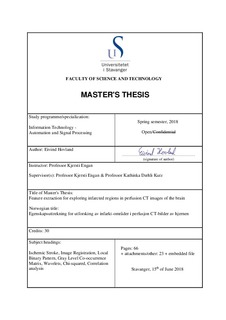| dc.contributor.advisor | Engan, Kjersti | |
| dc.contributor.advisor | Dæhli Kurz, Kathinka | |
| dc.contributor.author | Hovland, Eivind | |
| dc.date.accessioned | 2018-09-27T12:35:32Z | |
| dc.date.available | 2018-09-27T12:35:32Z | |
| dc.date.issued | 2018-06-15 | |
| dc.identifier.uri | http://hdl.handle.net/11250/2565028 | |
| dc.description | Master's thesis in Automation and signal processing | nb_NO |
| dc.description.abstract | In Norway, over 15 000 people suffer from acute cerebral stroke annually, it is the leading cause of adult long-term severe disability and a significant reason for admission to nursing homes. In Norway it is a prominent cause of death among adults, being the third leading cause of death. On a worldwide basis, 6.7 million deaths were due to stroke in 2012, most of them in low- and medium-income countries.
At Stavanger University Hospital (SUS), patients are routinely investigated using perfusion computed tomography (PCT) in the acute setting. The images acquired are used to calculate parametric color-coded maps describing the blood perfusion in the brain. These maps are interpreted, and thereby aid in deciding whether a patient need immediate thrombolytic treatment. This interpretation is critical in tailoring treatment to each patient, and thus saving lives and reducing the possibility of severe disability. The parametric maps are distant with regards to a certain diagnostic accuracy, and further refinement of the techniques and methods in use are desired. More accurate evaluation of PCT can lead to better guidance of whom to treat with thrombolytic- and interventional therapy, with the goal of better treatment for the patients.
The primary objective of this thesis is to arrange and process the available data material. Additionally, exploration of multiple features that describe a healthy hemisphere of the brain compared to a hemisphere with impaired perfusion is conducted.
Results show that textural features extracted by Local Binary Pattern (LBP) and wavelets can demonstrate a definite difference in the chi-squared distance measured in a healthy hemisphere compared to a hemisphere with impaired perfusion. Over different time-series, the distinctiveness of the features varied, by comparing them to the Time-Density Curves (TDC) for the actual patient, the better features seemed to be extracted from more complex wavelets like Daubechies-4 and Coiflet-4.
Textural features extracted from the
Gray Level Co-occurrence Matrices (GLCM) proved challenging to interpret, but by combining them with textural features extracted by Coiflet-wavelets, they were able to distinguish the two hemispheres for each patient. | nb_NO |
| dc.language.iso | eng | nb_NO |
| dc.publisher | University of Stavanger, Norway | nb_NO |
| dc.relation.ispartofseries | Masteroppgave/UIS-TN-IDE/2018; | |
| dc.rights | Navngivelse 4.0 Internasjonal | * |
| dc.rights.uri | http://creativecommons.org/licenses/by/4.0/deed.no | * |
| dc.subject | informasjonsteknologi | nb_NO |
| dc.subject | automatisering | nb_NO |
| dc.subject | signalbehandling | nb_NO |
| dc.subject | slagpasienter | nb_NO |
| dc.title | Feature extraction for exploring infarcted regions in perfusion CT images of the brain | nb_NO |
| dc.type | Master thesis | nb_NO |
| dc.subject.nsi | VDP::Teknologi: 500::Informasjons- og kommunikasjonsteknologi: 550 | nb_NO |

